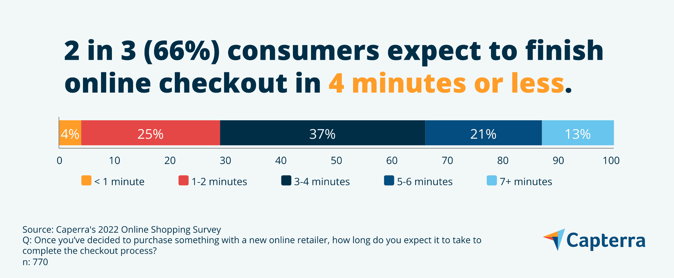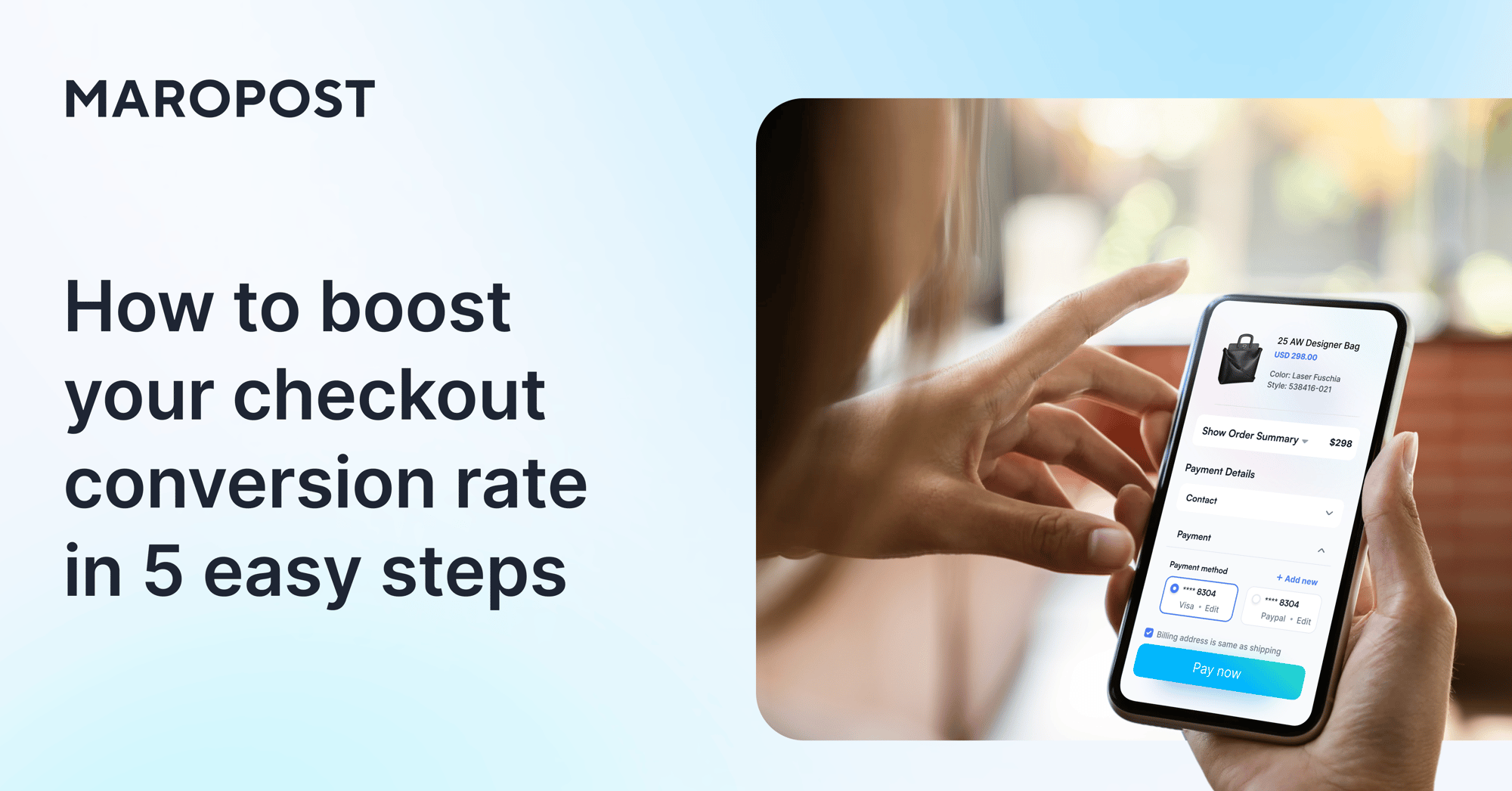TL;DR
- Checkout conversion rate is an ecommerce metric that measures how many shoppers complete their purchase after initiating the checkout process.
- Improving your checkout conversion rate is critical because it directly boosts revenue by turning a higher percentage of existing, ready-to-buy shoppers into paying customers.
- Checkout conversion rate is calculated by dividing the number of completed purchases by the number of initiated checkouts and multiplying by 100.
- Best practices for improving checkout conversion rate focus on simplifying the process, maximizing speed, offering multiple payment methods, using an AI chatbot, and continuous testing.
The checkout process is the most critical part of your customers’ online shopping experience, but it’s often the most overlooked. You might assume that once shoppers have added items to their carts and started checking out, they’re committed to buying, right?
Not exactly. In fact, a study from Baymard Institute revealed that the average cart abandonment rate is over 70%. It basically means that roughly 7 out of 10 online shoppers leave without completing their purchase. And that results in an estimated $111 billion to $136 billion in lost revenue each year for U.S. retailers, based on Coresight Research survey findings.
While users may abandon their shopping carts for a variety of reasons, a poorly optimized checkout process remains one of the primary drivers. In this blog, we’ve outlined the five essential steps you can take to improve your checkout and ensure higher conversions.
What is checkout conversion rate?
Checkout conversion rate is an ecommerce metric that measures how many shoppers complete their purchase after initiating the checkout process. Unlike the sales conversion rate, which measures the percentage of all website visitors who make a purchase, the checkout conversion rate focuses specifically on those who have already shown strong buying intent by starting checkout.
Factors like payment options, shipping fees, page load times, and customer effort all influence this metric. Tracking your checkout conversion rate can help you determine how effective your checkout process is at driving conversions. This is basically how you:
- Spot exactly where and why shoppers drop off during checkout
- See which checkout designs make the process smoother (or not)
- Test how different tweaks or layout changes affect your conversion rate
Understanding how many people actually make it through checkout and where friction is happening puts you in a better position to optimize the entire process, reduce cart abandonment, and increase sales.
What is the formula for checkout conversion rate?
To calculate your checkout conversion rate accurately, you need just a few key data points:
- The number of checkout sessions started (this is the count of unique sessions where shoppers begin the checkout process)
- The number of completed purchases (the number of shoppers who finish checkout and complete payment, resulting in a confirmed order)
Checkout Conversion Rate = (Number of Completed Purchases / Number of Initiated Checkouts) x 100
Let’s say 1,000 people initiated the checkout process and 700 completed the purchase. Your checkout conversion rate is (700/1000) x 100 = 70%. This means 70% of your customers who added items to their shopping carts made purchases.
5 Ways to optimize checkout conversion rate and increase sales
1. Simplify your checkout process
Your number one goal should be to make the checkout process as intuitive and user-friendly as possible for your customers. Any point of confusion or unnecessary step in the checkout flow can create friction and lead to cart abandonment. To create a truly frictionless experience, eliminate anything that makes customers pause or question what they need to do next. Here are some steps you can take:
- Remove unnecessary fields: Ask only for the essentials, like shipping and payment details. Every extra field adds friction and mental effort, increasing the chances that shoppers will abandon their carts.
- Offer a guest checkout option: For first-time shoppers, being forced to create an account can be a major turnoff. Let them complete their purchase as guests, then invite them to create an account after they’ve completed their purchase.
- Auto-populate and suggest: Let shoppers use auto-complete for their shipping and payment details and give them the option to save that info for next time. This reduces typing and makes it quicker and easier to complete their purchase.
- Avoid elements that can cause distractions: This can include promotional pop-ups (unless these are personalized AI-powered product recommendations), navigation links that lead away from the checkout, or other unnecessary visual clutter.
2. Make the checkout process as fast as possible
When it comes to online checkout, speed is everything – even a slight delay can cost you conversions. According to research from Capterra, 2 in 3 online shoppers (66%) expect to complete online checkout in 4 minutes or less, while 29% expect to finish it in under 2 minutes. A few steps to consider:
- Minimize redirects: Every redirect adds extra load time, slowing down the checkout process. Keep customers on the same page as much as possible to reduce latency and prevent drop-offs.
- Optimize your load times: Compress images, minify CSS and JavaScript files, and eliminate unnecessary code to improve page speed.
- Enable browser caching: Store frequently used resources like logos and icons in customers’ browsers, so they don’t have to be reloaded on every page, reducing overall load time.
A slow checkout page can be just as frustrating as a complicated one, so make sure your pages load quickly on both desktop and mobile.

3. Offer multiple payment methods
Checkout abandonment often spikes at the final stage because merchants fail to offer enough payment options, leaving shoppers unable or unwilling to complete their purchase. In fact, statistically, 56% of shoppers expect a variety of payment options on the checkout page.
Providing flexible payment methods can greatly improve conversion rates and appeal to a wider range of customer preferences, boosting both sales and customer satisfaction:
- Accept all major credit cards, such as Visa, Mastercard, American Express, and Discover. These are widely used and preferred by many shoppers.
- Accept payments via popular wallets like Apple Pay, Google Pay, PayPal, and Amazon Pay. Digital wallets are becoming increasingly popular.
- Offer a buy now, pay later (BNPL) option by integrating services like Klarna or Affirm that allow shoppers to split their payments into installments. Based on stats from Chargeflow, BNPL can increase conversions and boost average order values for merchants by 20–40%.
The more payment flexibility you provide, the more likely customers will find an option they prefer and complete their purchase.
4. Add an AI chatbot to your checkout page
Adding an AI chatbot widget to your checkout page can also help improve your checkout conversion rate and reduce abandoned carts. According to multiple studies, ecommerce chatbots can cut cart abandonment by 20-30%. Here’s how and why that works:
- Immediate support when shoppers are stuck: When shoppers get last-minute questions about shipping fees or encounter payment errors, an AI chatbot can offer instant assistance, reduce friction, and prevent drop-offs.
- Proactive cart abandonment recovery: AI chatbots can be set to send proactive messages (like “Need help completing your purchase?” or “Want to try a different payment method?”) when shoppers stay idle during checkout. This timely engagement can help recover otherwise lost sales.
- Personalized product recommendations: AI chatbots can proactively suggest items that pair perfectly with what shoppers already have in their cart. That can increase both conversions and average order value.
5. Test and optimize continuously
The work doesn’t stop once you’ve implemented a solid checkout process. Regularly testing and refining your ecommerce checkout is essential to keep up with changing customer expectations and behaviors. Even a minor adjustment (like changing the placement of a button or simplifying a form field) can have a significant impact on your checkout conversion rate.
- Use A/B testing: Experiment with different versions of your checkout page to identify what works best with your shoppers. Test everything from button colors to layout designs and checkout flow variations.
- Collect customer feedback: Use exit surveys or post-purchase feedback forms to understand why your customers abandon carts and what they’d like to see improved.
- Analyze checkout data: Use analytics tools to monitor where customers are dropping off. Are they leaving at the payment stage? Is there a specific field that’s causing confusion? Use this data to identify friction points and resolve them.
By taking a proactive approach to testing and optimization, you can stay ahead of potential issues and continue to refine your checkout process for maximum conversions.
Optimize your checkout conversion rate and drive more sales with Maropost Commerce Cloud
While optimizing the checkout experience is only one step in improving your online store performance, it’s an important one. With Maropost Commerce Cloud, you can increase your checkout conversion rate and drive more sales by making the checkout process quick, effortless, and intuitive for your shoppers.
On top of that, Maropost Commerce Cloud offers all the tools you need to manage your entire ecommerce engine effectively – from storefronts and massive product catalogs to inventory, pricing, orders, fulfillment, and customers – all from a single platform.
Book a demo now to see Maropost Commerce Cloud in action and learn why it’s the only solution you need to run your ecommerce business.
Frequently asked questions
What is a good checkout conversion rate in ecommerce?
The average checkout conversion rate varies depending on the industry, product type, and region. While there’s no universal benchmark for what is considered a good checkout conversion rate in ecommerce, various resources suggest that the typical range for most e-commerce stores is between 65%-85%. If your checkout conversion rate is below 60%, it might indicate serious friction points in your checkout process that you need to address.
What's the difference between checkout conversion rate and sales conversion rate?
Sales conversion rate is the percentage of all website visitors who complete a purchase, which reflects your online store’s performance. Checkout conversion rate is the percentage of shoppers who start the checkout process (e.g., land on the first checkout page) and successfully complete a purchase. It isolates your checkout performance and tells you how well your checkout process itself works once someone already has strong purchase intent.
Why should I care about my checkout conversion rate?
You should care about your checkout conversion rate because it directly impacts your overall revenue. A higher checkout conversion rate means more sales from your existing website traffic. Simply put, you turn more of your ready-to-buy shoppers into paying customers without needing to invest more money in marketing to bring in new traffic. And considering that nearly 70% of shopping carts get abandoned, every percentage point you gain in checkout conversion directly recovers a portion of those lost sales.
What are key performance indicators in ecommerce?
Key essential ecommerce metrics that you should be tracking beyond checkout conversion rate and include:
- Sales conversion rate: The percentage of your website visitors who make a purchase – shows how effectively your online store turns traffic into revenue.
- Cart abandonment rate: The percentage of shoppers who abandon their shopping carts without finalizing the purchase – reveals friction or hesitation before checkout.
- Bounce rate: The percentage of your website visitors who leave without any further action – reveals how relevant or engaging your website pages are.
- Average order value: The amount a customer typically spends in a single purchase – reveals customer spending habits and revenue growth opportunities.
- Customer lifetime value: The total revenue a customer is expected to generate for a business throughout their entire journey – reveals long-term profitability and retention.
- Repeat purchase rate: The percentage of customers who make more than one purchase – reveals how well you’re retaining customers.

